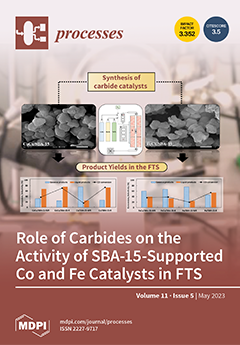This study was conducted in order to study the effect of different concentrations of lead pollution on the photosynthetic characteristics and growth of
Miscanthus floridulus, and to reveal its photosynthetic adaptability to lead stress. The differences of gas exchange parameters, chlorophyll fluorescence
[...] Read more.
This study was conducted in order to study the effect of different concentrations of lead pollution on the photosynthetic characteristics and growth of
Miscanthus floridulus, and to reveal its photosynthetic adaptability to lead stress. The differences of gas exchange parameters, chlorophyll fluorescence characteristics and photosynthetic pigment of two
Miscanthus floridulus populations, one population from Boluo an uncontaminated site, and another population from Dabaoshan, a mine site, were compared and studied through nutrient solution culture experiments treated with heavy metal lead (Pb) in green house. The results showed that (1) under Pb stress, the net photosynthetic rate (Pn), transpiration rate (Tr), stomatal conductance (Gs), intercellular carbon dioxide concentration (Ci), and chlorophyll content (Chl) of the leaves of the two populations decreased in different amplitude. Under moderate and severe Pb stress (80 mg·L
−1, 120 mg·L
−1, 240 mg·L
−1), the plant biomass of non-mining population and mining population plants were 54.5%, 39.7%, 29.4% and 70.4%, 54.7%, 50.9% of the control, respectively. (2) Stomatal restriction was the main factor for the Pn’s decrease in the leaves of the non-mine population under light Pb stress, while the non-stomatal restriction was the main factor for Pn’s decrease in the leaves of the non-mine population under middle and high Pb stresses. (3) Under Pb stress, the maximum photochemical efficiency (Fv/Fm) and potential activity (Fv/Fo) of PS II reaction centers in the two populations of
M. floridulus decreased. However, Fv/Fm and Fv/Fo showed a smaller decrease, but the capability to utilize light and the potential to activate PSII of the mine population remained higher than that of the non-mine population. The changes of photochemical quenching coefficient (qP) and non-photochemical quenching coefficient (NPQ) of PSⅡ showed that qP value decreased and NPQ value increased in the two populations under Pb stress. On the whole, the resistance mining area population had a low qP reduction and a large increase in NPQ. Electronic transfer rate (ETR) and PSII actual fluorescence efficiency (ΦPSII) of the mine population changed slightly under Pb stress. These results indicated that when under Pb stress, the electron transport activity and photosynthetic apparatus were damaged less in the mine population with high resistance than in the non-mine population with low resistance. Conclusion: the mining population of
M. floridulus has strong tolerance to Pb, which is suitable for the pioneer species of gramineae in vegetation restoration construction in metal mining area.
Full article





